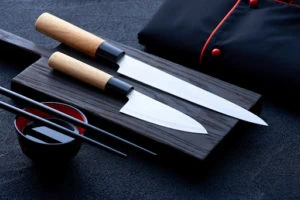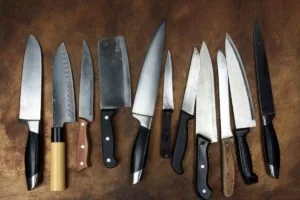
Today, it’s not unusual to walk into someone’s kitchen and see one beautiful knife that stands out from the rest. Chances are the special kitchen knife is a Japanese knife.
You used to only find Japanese knives in a professional chef’s kitchen, but these high-quality specialty knives have gained popularity amongst home cooks over the past few years. With so many different Japanese knives, many cooking enthusiasts now have a collection of these knives.
If you want to add a Japanese knife to your favorite kitchen tools, you’re in the right place. In this article, we detail some of the most popular types of Japanese knives to help you decide which one should be your first purchase.
Top 5 Different Types of Japanese Knives
There are several different types of Japanese knives, but almost all of them have different functions. Therefore, it’s important to take the time to learn about each one and figure out which knife is best for your cooking habits.
To give you a starting point to grow your knowledge of these specialty knives, here are the top 5 different types of Japanese knives.
Gyuto knife
Translating to “cow or beef knife,” the Gyuto knife is the Western knife equivalent of a chef’s knife. Chefs first used to cut through larger pieces of beef. Today, the Gyuto is considered an all-purpose Japanese kitchen knife suitable for most cooking tasks.
The Gyuto is a similar shape to the chef’s knife that you might be used to, ending with a pointed tip. What makes this knife different from the standard Western knife is it’s lighter and thinner but made out of heavier steel.
This results in more control over the knife and more precise movement rocking back and forth.
The Yoshihiro VG-10 46 Layers Hammered Damascus Gyuto Japanese Chefs Knife is versatile and has an extended tip that you can use for cutting meats, filleting fish, and slicing vegetables. The blade is forged and hammered with 46 layers of steel, this heavy-duty Japanese-style knife will survive for a long time with proper care.
Santoku knife
Like the Gyuto knife, the Santoku knife is also an all-purpose knife. The name translates to “three virtues,” and it is meant to cut fish, meat, and vegetables.
Influenced by Western cuisine, Santoku knives have a shorter tip than the Gyuto knives and are more angled. As a result, they cut more comfortably in an up and down motion rather than the rocking motion of the Gyuto knife.
This Shun DM-0702 Classic 7-inch Santoku Knife is handcrafted in Japan and is ideal for chopping, slicing, dicing, and mincing.
Made with 16 layers of stainless steel and a durable Pakkawood knife handle, this Japanese knife is meant to last as your kitchen companion.
Nakiri knife
Often mistaken for a cleaver, the Nakiri knife is a light, almost paper-thin knife with a rectangular shape. What is unique about this knife is that it has more steel at the front than other Japanese knives, causing it to be balanced forward.
This knife is one of the least heavy-duty knives on this list, as it is meant to cut soft vegetables. The flat edge easily pierces through the skin of these soft vegetables, ensuring a cleaner cut.
The Yoshihiro Kurouchi Black-Forged Blue Steel Nakiri Knife has a rustic, unpolished aesthetic thanks to its unique forge.
Made from Kurouchi stainless steel, this knife is also more forgiving to moisture than other similar knives, making it more durable. This knife is proudly made in Japan and is a great choice for those looking for the most authentic knives.
To learn more about the Nakiri knife, check out this article.
Yanagiba knife
Last but not least, we have the Yanagiba knife, one of the most unique and niche knives on this list but one that is also characteristically a traditional Japanese knife.
This knife translates to “willow blade” and is for slicing raw fish for sashimi, thanks to its long, thin blade curved at the tip. This single edge knife gets incredibly sharp and delivers the long singular motion required from a sashimi knife.
For a beginner Yanagiba knife that won’t break the bank, try this Kai Wasabi Black Yanagiba Knife.
Embellished with the Japanese character for “wasabi,” you don’t have to use this knife to only slice raw fish. It’s suitable to slice anything that you need thin and precisely cut.
What to Consider When Choosing Japanese Knives
Consider the following elements when choosing between different types of Japanese knives.
- The weight of the knife
- The comfort of your grip
- The length of the blade
- The material it’s made out of
What’s more, you must also understand how to take care of your Japanese knives. They are generally more expensive than other knives, and they often use high-quality material that requires special care and maintenance.
Here are some tips for maintaining your Japanese knives:
- Cut on the right surface, such as wood or bamboo, and not hard surfaces such as ceramic that can chip away at your knife’s blade.
- Ensure that you always keep your knife sharp and avoid cutting while the blade is dull. Use a whetstone to sharpen it.
- After washing, immediately wipe your knife clean. Keeping water on the blade for too long may result in unwanted rust.
Different Japanese Knife Types: Which One Is Best for You?

This list of different types of Japanese knives isn’t exhaustive, as there are several other knife options, such as:
- Bunka knife
- Garasuki knife
- Deba knife
- Kuritsuke knife
- Usuba knife
Although there are many more Japanese knives that we have not covered in this list, hopefully, we’ve explained why Japanese knives are so popular and given you a taste of what they can do.









Because Brock is the tallest member of the team at 6 foot 5 inches, when he’s not thinking about food, he’s eating his favorites: pizza, burgers, tacos and burritos. He's always experimenting with the latest kitchen gadgets and exploring new techniques in the kitchen.